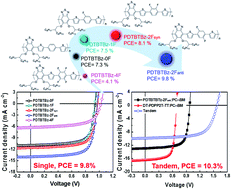High-efficiency photovoltaic cells with wide optical band gap polymers based on fluorinated phenylene-alkoxybenzothiadiazole†
Abstract
A series of semi-crystalline, wide band gap (WBG) photovoltaic polymers were synthesized with varying number and topology of fluorine substituents. To decrease intramolecular charge transfer and to modulate the resulting band gap of D–A type copolymers, electron-releasing alkoxy substituents were attached to electron-deficient benzothiadiazole (A) and electron-withdrawing fluorine atoms (0–4F) were substituted onto a 1,4-bis(thiophen-2-yl)benzene unit (D). Intra- and/or interchain noncovalent Coulombic interactions were also incorporated into the polymer backbone to promote planarity and crystalline intermolecular packing. The resulting optical band gap and the valence level were tuned to 1.93–2.15 eV and −5.37 to −5.67 eV, respectively, and strong interchain organization was observed by differential scanning calorimetry, high-resolution transmission electron microscopy and grazing incidence X-ray scattering measurements. The number of fluorine atoms and their position significantly influenced the photophysical, morphological and optoelectronic properties of bulk heterojunctions (BHJs) with these polymers. BHJ photovoltaic devices showed a high power conversion efficiency (PCE) of up to 9.8% with an open-circuit voltage of 0.94–1.03 V. To our knowledge, this PCE is one of the highest values for fullerene-based single BHJ devices with WBG polymers having a band gap of over 1.90 eV. A tandem solar cell was also demonstrated successfully to show a PCE of 10.3% by combining a diketopyrrolopyrrole-based low band gap polymer.



 Please wait while we load your content...
Please wait while we load your content...